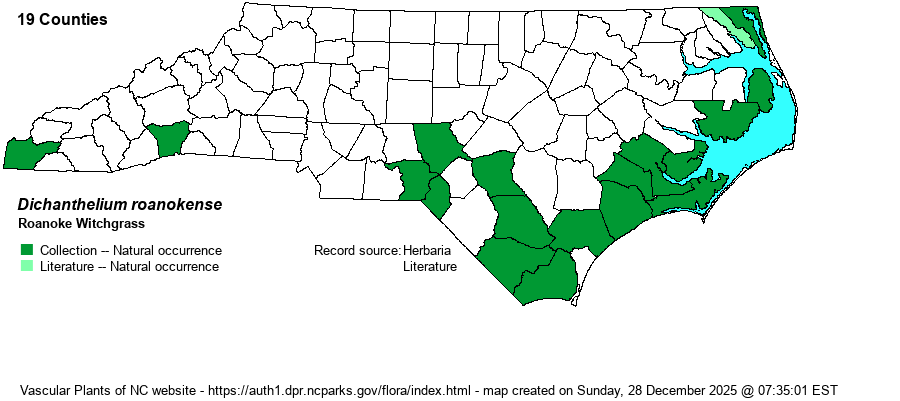| Author | (Ashe) LeBlond | |
| Distribution | Outer and southern Coastal Plain, including the Sandhills and the northern Outer Banks (Roanoke Island). Absent, apparently, from nearly all of the central and northern Coastal Plain. Disjunct to montane sites in Henderson and Cherokee counties. Our map reflects annotations made by Richard LeBlond (mostly) or other grass experts.
Coastal Plain, DE to FL and TX; Jamaica. Disjunct to southwestern NC and central TN. | |
| Abundance | Uncommon to infrequent. The website editors suggest a State Rank of S3?; probably not scarce enough to put on a Watch List. However, the NCNHP includes it on the Watch List, with a State Rank of S2. | |
| Habitat | Margins of blackwater streams and small rivers, openings in gum-cypress swamps, wet peaty meadows. Montane populations occur in brownwater systems. | |
| Phenology | Flowering and fruiting May-September. | |
| Identification | This is a member of the D. dichotomum complex. In this species and 3 others, the stem nodes are glabrous. It differs from D. dichotomum (sensu stricto) by having smaller spikelets (1.5-1.8 mm long vs. 1.8-2.3 mm long in that widespread species) and that are purplish basally (vs. green basally in D. dichotomum). It differs from D. yadkinense by the smaller spikelets (1.5-1.8 mm long vs. 1.9-2.6 mm long in that species) and the leaf blades less than 1 cm wide (vs. greater than 1 cm wide in D. yadkinense). It differs from D. lucidum by its erect stems versus weak and reclining stems in that species. | |
| Taxonomic Comments | In older texts completely lumped within Panicum dichotomum. FNA treats it as a subspecies of D. dichotomum.
A note about Dichanthelium: This genus is not impossible to identify to species! But it takes applied effort over a period of time in order to learn the various species and what their morphological limits are. We strongly recommend that you read the introduction to the treatment in Weakley et al. (2023), written by Richard LeBlond. LeBlond has made order out of near chaos, and his keys work very well for our plants. Most Dichanthelium taxa ("Dichs") do not grow everywhere indiscrimminately, but prefer certain well-defined habitats. Note that most species produce flowers/fruits twice a year -- a vernal period and an autumnal period -- and that measurements of spikelets and achenes are taken from vernal plants. Some species also have a third, or summer, period. In the vernal period there is a single inflorescence at the tip of the stem. In the autumnal period, plants produce elongate branches with bunched (congested) leaves and so look quite different from vernal plants. Inflorescences are produced in leaf axils as well as at the tips of branches. NOTE: Older texts had these species essentially all within the very large genus Panicum. "Dich" species are typically named as "Witchgrass" and Panicum species named as "Panicgrass". | |
| Other Common Name(s) | None | |
| State Rank | S2 [S3?] | |
| Global Rank | G4? | |
| State Status | W1 | |
| US Status | | |
| USACE-agcp | | |
| USACE-emp | | |

